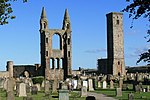St Andrews Castle

St Andrews Castle is a ruin located in the coastal Royal Burgh of St Andrews in Fife, Scotland. The castle sits on a rocky promontory overlooking a small beach called Castle Sands and the adjoining North Sea. There has been a castle standing at the site since the times of Bishop Roger (1189–1202), son of the Earl of Leicester. It housed the burgh’s wealthy and powerful bishops while St Andrews served as the ecclesiastical centre of Scotland during the years before the Protestant Reformation. In their Latin charters, the Archbishops of St Andrews wrote of the castle as their palace, signing, "apud Palatium nostrum."The castle's grounds are now maintained by Historic Environment Scotland as a scheduled monument. The site is entered through a visitor centre with displays on its history. Some of the best surviving carved fragments from the castle are displayed in the centre, which also has a shop.
Excerpt from the Wikipedia article St Andrews Castle (License: CC BY-SA 3.0, Authors, Images).St Andrews Castle
The Scores,
Geographical coordinates (GPS) Address Website External links Nearby Places Show on map
Geographical coordinates (GPS)
| Latitude | Longitude |
|---|---|
| N 56.3419 ° | E -2.7901 ° |
Address
St Andrews Castle
The Scores
KY16 9AR
Scotland, United Kingdom
Open on Google Maps









